【NodeJs-5天学习】第三天实战篇③ ——基于MQTT的环境温度检测
面向读者群体
- ❤️ 电子物联网专业同学,想针对硬件功能构造简单的服务器,不需要学习专业的服务器开发知识 ❤️
- ❤️ 业余爱好物联网开发者,有简单技术基础,想针对硬件功能构造简单的服务器❤️
- ❤️ 本篇创建记录 2023-03-12 ❤️
- ❤️ 本篇更新记录 2023-03-12 ❤️
技术要求
- 有HTML、CSS、JavaScript基础更好,当然也没事,就直接运行实例代码学习
专栏介绍
- 通过简短5天时间的渐进式学习NodeJs,可以了解到基本的服务开发概念,同时可以学习到npm、内置核心API(FS文件系统操作、HTTP服务器、Express框架等等),最终能够完成基本的物联网web开发,而且能够部署到公网访问。
🙏 此博客均由博主单独编写,不存在任何商业团队运营,如发现错误,请留言轰炸哦!及时修正!感谢支持!🎉 欢迎关注 🔎点赞 👍收藏 ⭐️留言📝
1. 前言
说到物联网,基本上离不开一个网络协议——MQTT。而在NodeJs中集成MQTT服务器也是非常简单易行,这里我们就构建一个简单的基于本地MQTT服务器的环境温度检测小系统。
2.实现思路
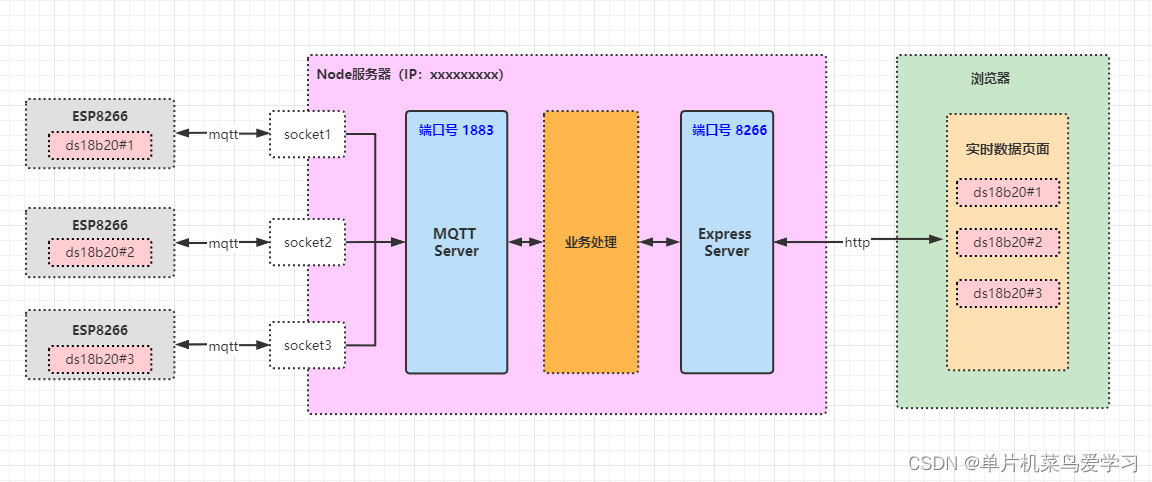
- ① 本地部署一个
MQTT服务器,端口号是1883,负责监听ESP8266通过mqtt协议上传上来的温度数据 - ② 本地部署一个
Express服务器,端口号是8266,负责处理浏览器请求静态UI数据展示页面,静态页面由html、css、js编写 - ③ 核心业务处理包括处理温度数据,记录数据到
fs文件系统 - ④ 设备端存在多个ESP8266, 每个8266都是一个Node节点的概念,上传该节点对应的ds18b20数据,我们需要对ds18b20进行
编号,类似于#1,#2,#3等等。
2.1 NodeJs服务器代码
服务器代码包括两部分:
- mqtt服务器,负责和设备端进行通信
- express服务器,负责web页面展示数据
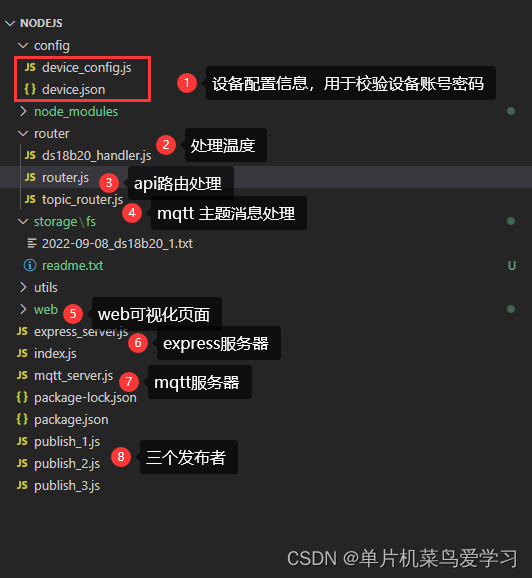
2.2.1 本地部署MQTT服务器,端口1883
const {mqttTopic} = require('./router/topic_router.js')
const {getIPAdress} = require('./utils/utils.js')
const deviceConfig = require('./config/device_config.js')
// 2、创建web服务器
const myHost = getIPAdress();
const aedes = require('aedes')()
const server = require('net').createServer(aedes.handle)
const port = 1883
server.listen(port, function () {
console.log("mqtt 服务器启动成功 mqtt://"+ myHost +":" + port);
});
// API文档:https://github.com/moscajs/aedes/blob/main/docs/Aedes.md
/********************************客户端连接状态************************************************************/
//Some Use Cases:
// - Rate Limit / Throttle by client.conn.remoteAddress
// - Check aedes.connectedClient to limit maximum connections
// - IP blacklisting
// Any error will be raised in connectionError event.
aedes.preConnect = function(client, packet, callback) {
// 这个时候还没有 client.id
console.log('服务器收到客户端: \x1b[31m' + (client ? client.conn.remoteAddress : client) + '\x1b[0m preConnect');
callback(null, true)
}
// aedes.preConnect = function(client, packet, callback) {
// callback(new Error('connection error'), client.conn.remoteAddress !== '::1')
// }
// 连接身份验证,这个方法在preConnect之后
aedes.authenticate = function (client, username, password, callback) {
console.log('客户端连接身份验证: \x1b[31m' + (client ? client.id : client) + '\x1b[0m authenticate');
if (client.id && deviceConfig.authID(client.id)) {
callback(null, deviceConfig.authLogin(client.id, username, password.toString()))
return
}
var error = new Error('Auth error,非法ID')
error.returnCode = 4
callback(error, null)
}
// aedes.authenticate = function (client, username, password, callback) {
// var error = new Error('Auth error')
// error.returnCode = 4
// callback(error, null)
// }
// 客户端正在连接
aedes.on('client', function (client) {
console.log('\x1b[33m' + (client ? client.id : client) + '\x1b[0m', '客户端正在连接到 broker', aedes.id);
});
// 客户端连接成功
aedes.on('clientReady', function (client) {
console.log('\x1b[33m' + (client ? client.id : client) + '\x1b[0m', '客户端连接成功到 broker', aedes.id);
});
// 客户端连接断开
aedes.on('clientDisconnect', function (client) {
console.log('\x1b[31m' + (client ? client.id : client) + '\x1b[0m', '客户端连接断开 clientDisconnect');
});
// 客户端连接错误
aedes.on('clientError', function (client, error) {
console.log('\x1b[31m' + (client ? client.id : client) + '\x1b[0m', '客户端连接错误 clientError');
});
// 客户端连接异常
// Emitted when an error occurs. Unlike clientError it raises only when client is uninitialized.
aedes.on('connectionError', function (client, error) {
console.log('\x1b[31m' + (client ? client.id : client) + '\x1b[0m', '客户端连接异常 connectionError');
});
// CONNACK —— 确认连接请求
// (服务端发送CONNACK报文响应从客户端收到的CONNECT报文。服务端发送给客户端的第一个报文必须是CONNACK)
aedes.on('connackSent', function (packet , client ) {
console.log('服务端确认连接给到\x1b[31m' + (client ? client.id : client) + '\x1b[0m connackSent', packet);
});
/********************************客户端连接状态************************************************************/
/********************************心跳应答************************************************************/
// 客户端连接超时
aedes.on('keepaliveTimeout', function (client, error) {
console.log('\x1b[31m' + (client ? client.id : client) + '\x1b[0m', '客户端心跳连接超时 keepaliveTimeout');
});
// Emitted an QoS 1 or 2 acknowledgement when the packet successfully delivered to the client.
aedes.on('ack', function (packet , client) {
console.log('服务端应答客户端: \x1b[31m' + (client ? client.id : client) + '\x1b[0m 内容:', packet);
});
// Emitted when client sends a PINGREQ.
aedes.on('ping', function (packet , client) {
console.log('\x1b[31m' + (client ? client.id : client) + '\x1b[0m', '客户端发送过来心跳 Ping');
});
/********************************心跳应答************************************************************/
/********************************主题相关************************************************************/
aedes.on('publish', function (packet, client) {
if(client) {
console.log('服务器收到客户端\x1b[31m' + (client ? client.id : client) + '\x1b[0m', '发布内容:', packet);
mqttTopic.route(packet.topic, packet.payload)
} else {
console.log('服务器发布内容:', packet);
}
});
// Emitted when client successfully subscribe the subscriptions in server.
aedes.on('subscribe', function (subscriptions , client) {
console.log('服务器收到客户端: \x1b[31m' + (client ? client.id : client) + '\x1b[0m', '主题订阅:', subscriptions);
});
// 对订阅主题进行校验
aedes.authorizeSubscribe = function (client, sub, callback) {
// if (sub.topic === 'aaaa') {
// return callback(new Error('wrong topic'))
// }
// if (sub.topic === 'bbb') {
// // overwrites subscription
// sub.topic = 'foo'
// sub.qos = 1
// }
callback(null, sub)
}
// Emitted when client successfully unsubscribe the subscriptions in server.
aedes.on('unsubscribe', function (unsubscriptions , client) {
console.log('服务器收到客户端: \x1b[31m' + (client ? client.id : client) + '\x1b[0m', '主题注销:', unsubscriptions);
});
/********************************主题相关************************************************************/
2.2.1.1 用户校验
// 连接身份验证,这个方法在preConnect之后
aedes.authenticate = function (client, username, password, callback) {
console.log('客户端连接身份验证: \x1b[31m' + (client ? client.id : client) + '\x1b[0m authenticate');
if (client.id && deviceConfig.authID(client.id)) {
callback(null, deviceConfig.authLogin(client.id, username, password.toString()))
return
}
var error = new Error('Auth error,非法ID')
error.returnCode = 4
callback(error, null)
}
这里会对clientid进行校验,通过之后再进行校验用户名字和密码。相当于三元组都得通过。
校验配置:
[{
"id": "1",
"mac": "B0:E1:7E:70:25:CD",
"name": "user",
"psw": "123456"
}, {
"id": "2",
"mac": "78:DA:07:04:5D:18",
"name": "user",
"psw": "123456"
}, {
"id": "3",
"mac": "30:FC:68:19:52:A4",
"name": "user",
"psw": "123456"
}]
包括四个元素:
- clientid
- mac地址
- 用户名字name
- 用户密码psw
接下来看看校验代码实现:
const fs = require('fs')
// 设备配置信息,需要通过配置校验才会通过
var fileName = './config/device.json';
var config = JSON.parse(fs.readFileSync(fileName));
var idToMacMap = new Map()
var idToValueMap = new Map()
config.forEach(element => {
var id = element.id
var mac = element.mac
if (idToMacMap.has(id)) {
throw console.error('device_config配置文件出现重复ID,请检查!' + id);
}
idToMacMap.set(id, mac)
idToValueMap.set(id, element)
})
console.log("用户设备配置信息:")
console.log(idToValueMap)
// 判断设备是否是合法设备,这里只是判断名字,最好是连着mac地址一起判断
function authID(deviceId, mac) {
return idToMacMap.has(deviceId)
}
function authLogin(deviceId, name, psw) {
var value = idToValueMap.get(deviceId)
console.log(value)
if (!value){
console.log('不存在ID:' + deviceId)
return false
}
return value.name === name && value.psw === psw
}
module.exports = {
authID,
authLogin
}
主要是把配置文件变成一个map映射对象,key是clientid。判断规则主要是判断是否存在对应的clientid,再把具体值拿出来进行下一轮比较。
2.2.1.2 主题消息处理
// 导入所需插件模块
const fs = require('fs')
const querystring = require('querystring')
const ds18b20Handler = require('./ds18b20_handler')
var mqttTopic = {}
var routes = []
const USE_DEFAULT = 0
const USE_JSON = 1
const USE_FORM = 2
// 注入主题和处理方法
mqttTopic.use = function(path, dataType, action){
if (!dataType) dataType = USE_DEFAULT
routes.push([path, dataType, action])
}
// 路由匹配
mqttTopic.route = function(topic, payload) {
for (let index = 0; index < routes.length; index++) {
const route = routes[index];
var key = route[0]
var dataType = route[1]
var action = route[2]
if (topic === key) {
var rawBody = payload.toString()
if (dataType == USE_JSON) {
try {
action(JSON.parse(rawBody))
} catch (e) {
// 异常内容
console.log('Invalid JSON')
}
} else if(dataType == USE_FORM) {
action(querystring.parse(req.rawBody))
} else {
action(payload)
}
}
}
}
mqttTopic.use('SysThingPropertyPost',USE_JSON, (payload)=>{
console.log(payload)
if (payload.params.temp) {
ds18b20Handler.setCurrentTemp(payload.id, payload.params.temp)
ds18b20Handler.saveToFile(payload.id, payload.params.temp)
}
})
module.exports = {
mqttTopic
}
主要是处理映射对应的mqtt主题,目前这里是处理 SysThingPropertyPost,这里是8266订阅的主题。
2.2.2 本地部署Express服务器,端口8266
// 1、导入所需插件模块
const express = require("express");
const {getIPAdress} = require('./utils/utils.js')
const bodyParser = require('body-parser')
const {router} = require('./router/router.js')
// 2、创建web服务器
let app = express();
const port = 8266; // 端口号
const myHost = getIPAdress();
// 3、注册中间件,app.use 函数用于注册中间件
// 3.1 预处理中间件
app.use(bodyParser.json());
app.use(bodyParser.urlencoded({ extended: true }));
app.use(function(req, res, next){
// url地址栏出现中文则浏览器会进行iso8859-1编码,解决方案使用decode解码
console.log('解码之后' + decodeURI(req.url));
console.log('URL:' + req.url);
if (req.method.toLowerCase() === 'post') {
console.log(req.body);
}
next()
})
// 3.2 路由中间件
app.use(router)
app.use(express.static('web')) // express.static()方法,快速对外提供静态资源
// 3.3 错误级别中间件(专门用于捕获整个项目发生的异常错误,防止项目奔溃),必须注册在所有路由之后
app.use((err, req, res, next) => {
console.log('出现异常:' + err.message)
res.send('Error: 服务器异常,请耐心等待!')
})
// 4、启动web服务器
app.listen(port,() => {
console.log("express 服务器启动成功 http://"+ myHost +":" + port);
});
这里注入了api路由和静态文件路由。
// 3.2 路由中间件
app.use(router)
app.use(express.static('web')) // express.static()方法,快速对外提供静态资源
2.2.2.1 api路由中间件
// 1、导入所需插件模块
const express = require("express")
const ds18b20Handler = require('./ds18b20_handler.js')
// 2、创建路由对象
const router = express.Router();
// 3、挂载具体的路由
// 配置add URL请求处理
// 参数1:客户端请求的URL地址
// 参数2:请求对应的处理函数
// req:请求对象(包含与请求相关属性方法)
// res:响应对象(包含与响应相关属性方法)
// 处理DS18B20 GET 和 POST请求
router.get('/ds18b20/:id/temp', (req, res) => {
var id = req.params.id
var temp = ds18b20Handler.getCurrentTemp(`${id}`)
console.log(`${temp}`)
temp ? res.send(`${temp}`) : res.send('0')
})
// 4、向外导出路由对象
module.exports = {
router
}
这里注册了 /ds18b20/:id/temp,设置了一个动态参数id,用来区分不同的ds18b20设备,同时这个接口提供给浏览器调用。
2.2.2.2 静态路由
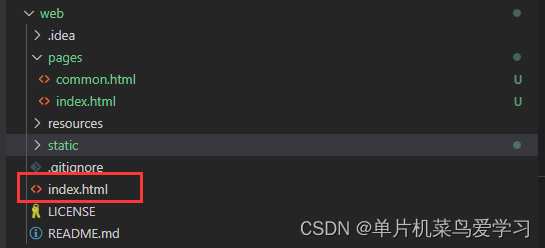
具体web代码可以细看这一块,主要是用到了echart来绘制曲线图。
2.2.3 核心业务处理
主要就是处理json数据,格式如下:
{
id: '1',
version: '1.0',
method: 'node.property.post',
params: { temp: '15' }
}
最终我们会把这些数据存到文件里面。
mqttTopic.use('SysThingPropertyPost',USE_JSON, (payload)=>{
console.log(payload)
if (payload.params.temp) {
ds18b20Handler.setCurrentTemp(payload.id, payload.params.temp)
// 保存到文件
ds18b20Handler.saveToFile(payload.id, payload.params.temp)
}
})
2.2 ESP8266代码,这里以#1为例
/**
* 功能: 串口输出 DS18B20 数据,并且在WebServer页面展示
*
* 运行前提:
* 这里尽量把第三方库集成在工程目录下,如出现xxxx库找不到,请按照下面方式进行安装。
*
* - 缺少 onewire。 工具 -> 管理库 -> 搜索 onewire -> 安装最新版本
* - 缺少 dallas。 工具 -> 管理库 -> 搜索 Dallas -> 安装最新版本
* - 缺少 PubSubClient。 工具 -> 管理库 -> 搜索 PubSubClient -> 安装
* - 缺少 ArduinoJson。工具 -> 管理库 -> 搜索 ArduinoJson -> 安装下载6.x版本
*
* 详细描述:
* 1、esp8266通过 D4 IO和 DS18B20 通信
* 2、读取 DS18B20 传感器数据
* 3、串口输出 传感器数据
*
* 硬件材料:
* 1、ESP8266-12 NodeMcu板子
* 2、面包板
* 3、DS18B20 模块
* 4、电源模块
* 5、若干杜邦线
*
* 接线:
* 1. DS18B20 Vcc ----> NodeMcu 3V3
* DS18B20 GND ----> NodeMcu GND
* DS18B20 Data ----> NodeMcu D4
*/
#include <OneWire.h> // 引入单总线库
#include <DallasTemperature.h> // 引入DS18B20库
#include <ESP8266WiFi.h> // 引入WiFi核心库
#include "PubSubClient.h" // 引入MQTT处理库
#include "NodeIoTSDK.h" // 引入巴法云 IoT SDK
#include <Ticker.h>
/******************* 常量声明 **********************/
#define SSID "TP-LINK_5344" // 填入自己的WiFi账号
#define PASSWORD "zzzzz" // 填入自己的WiFi密码
#define INTERVAL 10000 // 读取时间间隔,默认10s
#define DS18B20_PIN D4 // DS18B20 数据口
#define BUFFER_SIZE 200
//-------- mqtt设置信息 -------//
// 三元组信息
#define ID "1" // 表示不同的设备 "2" "3"
#define NAME "user"
#define PSW "123456"
#define MQTT_SERVER "192.168.1.105"
#define MQTT_PORT 1883
//-------- mqtt设置信息 -------//
/******************* 常量声明 **********************/
/******************* 函数声明 **********************/
void DS18B20_Read(void); // 读取 DS18B20
void DS18B20_Init(void); // 初始化 DS18B20
void initWifiConnect(void); // 初始化Wifi连接
void doWiFiConnectTick(void); // 检测WiFi连接状态
void readDSTemperatureF(void); // 读取华氏温度
void readDSTemperatureC(void); // 读取摄氏温度
void initNodeIotSDK(void); // 初始化Node IOT SDK
void sendDataToNode(void); // 发送数据到MQTT平台
/******************* 函数声明 **********************/
/******************* 变量定义 **********************/
OneWire oneWire(DS18B20_PIN); // 建立单总线访问入口
DallasTemperature sensors(&oneWire); // 单总线入口和DS18B20绑定
float temperatureC = 0.0; // 记录当前摄氏温度
float temperatureF = 0.0; // 记录当前华氏温度
unsigned long previousMillis = 0; // 记录上次读取的时间戳
Ticker delayTimer; // 表示定时模块,用来做一个定时器
unsigned int maxCount = 0; // 记录连续超过阈值的次数
char data[BUFFER_SIZE];
static WiFiClient espClient; // TCP Client
/******************* 变量定义 **********************/
void setup() {
delay(2000); // 延时2秒,用于等待系统上电稳定
Serial.begin(115200); // 初始化串口,波特率 115200
Serial.println("");
Serial.println("project run~");
DS18B20_Init(); // 初始化 DS18B20
initWifiConnect(); // 初始化Wifi连接
initNodeIotSDK(); // 初始化Node IOT SDK
ESP.wdtEnable(5000); // 启用看门狗
}
void loop() {
ESP.wdtFeed();// 定时喂狗
doWiFiConnectTick(); // wifi连接状态检测以及重连
unsigned long currentMillis = millis(); // 获取当前时间戳
if(currentMillis - previousMillis >= INTERVAL) // 每隔一段时间读取一下传感器数据 interval为时间间隔
{
previousMillis = currentMillis; // 记录当前时间戳
DS18B20_Read(); // 获取 DS18B20 数据,并且串口输出
sendDataToNode(); // 发送数据到Node服务器
}
// Wifi处于连接状态
if (WiFi.status() == WL_CONNECTED) {
// 检测MQTT
NodeIoTSDK::loop();
}
delay(2000); // 延时2秒
}
/**
* 初始化IOT SDK
*/
void initNodeIotSDK(void)
{
// 初始化 iot sdk,需传入 wifi 的 client,和设备产品信息
NodeIoTSDK::begin(espClient, ID, NAME, PSW, MQTT_SERVER, MQTT_PORT);
}
/**
* 读取 DS18B20 温度
*/
void DS18B20_Read(void)
{
readDSTemperatureC(); // 读取摄氏温度
readDSTemperatureF(); // 读取华氏温度
}
/**
* 初始化 DS18B20
*/
void DS18B20_Init(void)
{
sensors.begin(); // 启动DS18B20 传感器
}
/**
* 检测WiFi连接状态
*/
void doWiFiConnectTick(void)
{
static uint32_t lastWiFiCheckTick = 0; // 记录最近一次检测WiFi连接状态的时间点
static uint32_t disConnectCount = 0; // 记录WiFi断开连接的次数
if(WiFi.status() == WL_CONNECTED) // 当前WiFi处于连接状态
{
disConnectCount = 0;// 重置WiFi断开连接为0
return;
}
if(millis() - lastWiFiCheckTick > 1000) // 检测间隔大于1秒
{
lastWiFiCheckTick = millis(); // 记录时间点
Serial.println("WiFi disConnect!"); // 串口输出.表示设备已经断开连接
disConnectCount++; // WiFi断开连接的次数累计加1
if(disConnectCount>=40) // 断开连接累计次数达到40次,表示可能wifi连接异常
{
delayRestart(1); //一直连接不上就重启ESP系统
}
}
}
/**
* 延时t秒后重启ESP
* @param t t秒
*/
void delayRestart(float t)
{
Serial.print("Restart after ");
Serial.print(t);
Serial.println("s");
// 开启一个定时器,定时时间为t秒
delayTimer.attach(t, []() {
Serial.println("\r\nRestart now!");
ESP.restart();// 重启ESP模块
});
}
/**
* 初始化Wifi连接
*/
void initWifiConnect(void)
{
Serial.printf("Connecting to WiFi:%s\n",SSID);// 串口打印当前WiFi热点的名字
WiFi.disconnect(); // 默认断开之前的连接,回归初始化非连接状态
WiFi.mode(WIFI_STA); // 设置ESP工作模式为Station模式
WiFi.begin(SSID, PASSWORD); // 连接到WiFi
int cnt = 0; // 记录重试次数
while (WiFi.status() != WL_CONNECTED) // 当还没有连接上WiFi热点时
{
delay(1000); // 延时等待1秒
cnt++; // 累计次数+1
Serial.print("."); // 串口输出.表示设备正在连接WiFi热点
if(cnt>=40) // 超过40秒还没有连接上网络
{
delayRestart(1); //一直连接不上就重启ESP系统
}
}
Serial.println(WiFi.localIP()); // 打印当前IP地址
}
/**
* 读取温度
*/
char* getSensorReadings(){
memset(data, 0, BUFFER_SIZE); //清空缓存数据
sprintf(data,"{\"temperature\":%s}", String(temperatureC).c_str());
Serial.println(data);
return data;
}
/**
* 读取摄氏温度
*/
void readDSTemperatureC(void)
{
// Call sensors.requestTemperatures() to issue a global temperature and Requests to all devices on the bus
sensors.requestTemperatures(); // 请求温度
temperatureC = sensors.getTempCByIndex(0); // 读取温度值
if(temperatureC == -127.00) // 如果温度等于 -127,证明数据无效
{
Serial.println("Failed to read from DS18B20 sensor"); // 串口输出无效提示信息
} else {
Serial.printf("Temperature Celsius: %.2f *C\n", temperatureC); // 串口输出当前温度
}
}
/**
* 读取华氏温度
*/
void readDSTemperatureF(void)
{
// Call sensors.requestTemperatures() to issue a global temperature and Requests to all devices on the bus
sensors.requestTemperatures(); // 请求温度
temperatureF = sensors.getTempFByIndex(0); // 读取温度值
if(int(temperatureF) == -196) // 如果温度等于 -196,证明数据无效
{
Serial.println("Failed to read from DS18B20 sensor"); // 串口输出无效提示信息
} else {
Serial.printf("Temperature Fahrenheit: %.2f *C\n", temperatureF); // 串口输出当前温度
}
}
/**
* 发送数据到云平台
*/
void sendDataToNode(void)
{
memset(data, 0, BUFFER_SIZE); //清空缓存数据
sprintf(data,"{\"temp\":%s}", String(temperatureC).c_str()); // 构成需要上传的Json数据
Serial.printf("param:%s\n", data); // 串口输出最终发送的数据
NodeIoTSDK::send(data); // 发送数据到Node
}
2.3 测试效果
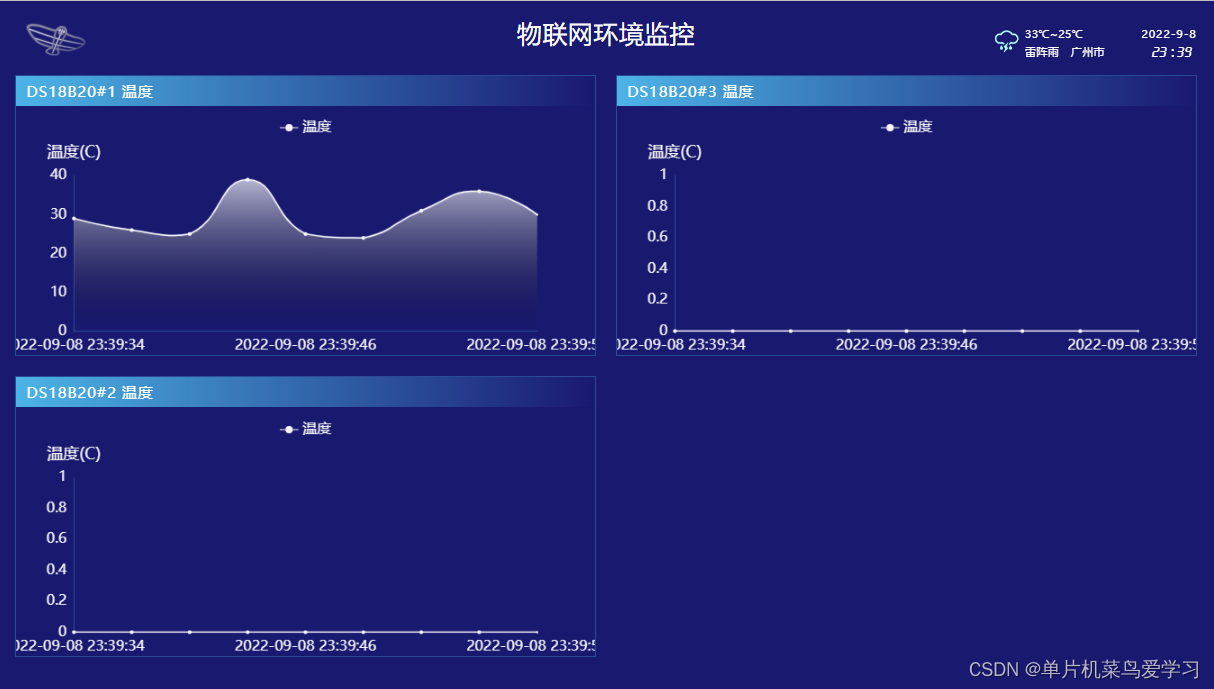
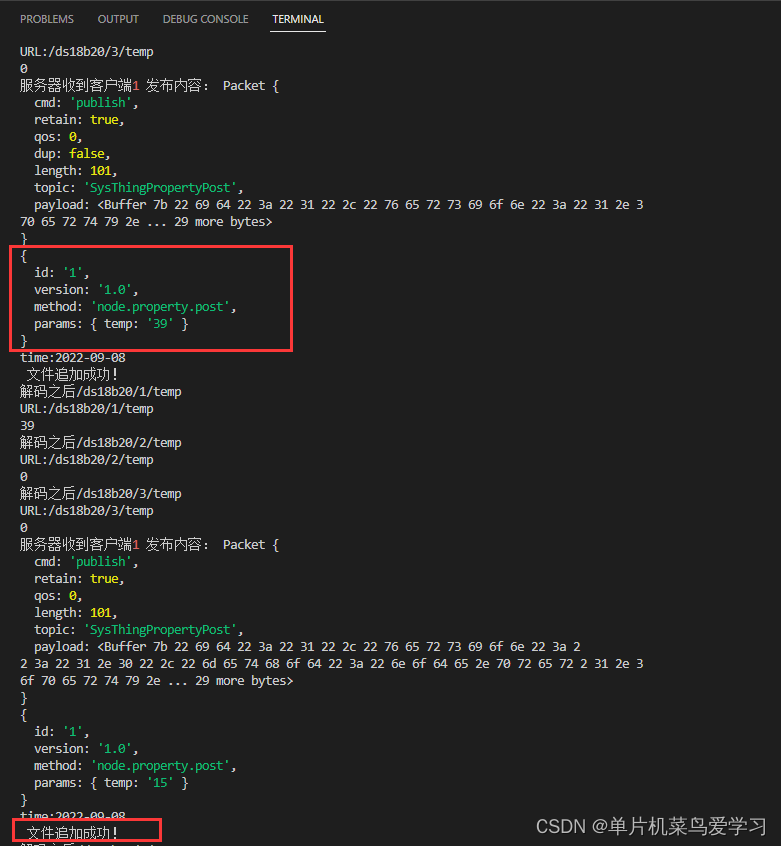
至此,一个简单的基于MQTT的环境温度检测系统就可以了。
4.总结
篇③结合ESP8266来开发简单物联网应用——获取多个ds18b20节点的温度,上报到本地部署的mqtt服务器,同时启动express服务器,提供一个可视化页面查看曲线图。麻雀虽小五脏俱全,初学者需要理解文件系统、服务请求等等对应的知识点并加以实际应用。























 6588
6588











 被折叠的 条评论
为什么被折叠?
被折叠的 条评论
为什么被折叠?










